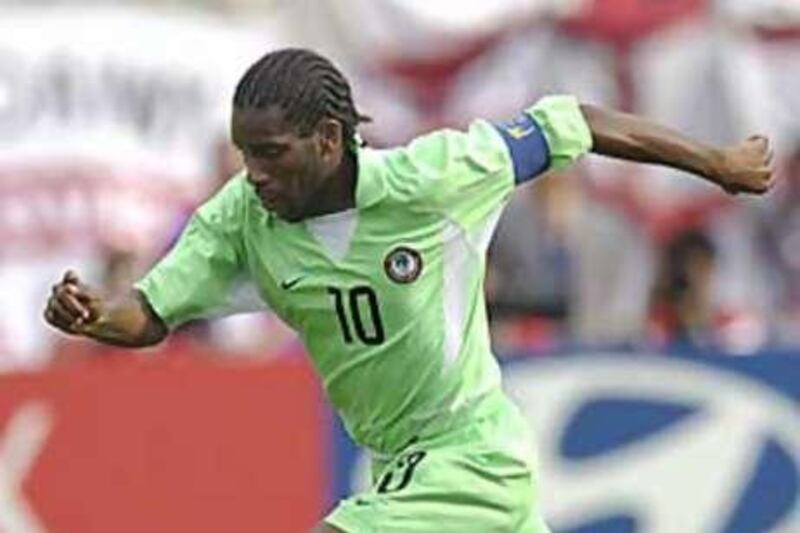There has been much expectation in the build-up to the first African World Cup that at least one of the continent's teams will be inspired by the historical significance of the occasion and will be carried on a tide of popular feeling to the quarter-finals and beyond. Perhaps they will, and the spirit of pan-Africanism certainly remains strong enough that local fans are likely to support African teams, although anybody expecting too much from supposed "home" advantage should bear in mind that Abidjan is, to within 100 miles, equidistant from Munich, where Ivory Coast played their last World Cup match, and Port Elizabeth, where they will play their opening game this tournament.
Besides which, the evidence of the African Cup of Nations in Angola earlier this year suggests none of the African contenders have anything like the capacity to make the same impact as, say, Senegal did in reaching the last eight in 2002. Algeria were inconsistent and so were Nigeria, Cameroon were over-reliant on Samuel Eto'o, Ivory Coast were poor at the back with only Ghana suggesting any sort of cohesiveness. And although Algeria at least included a playmaker in Karim Ziani, all five lacked creativity, particularly in wide areas.
The problem seems particularly acute in west Africa. When Nigeria won the Olympic gold medal in 1996, and performed creditably at the World Cups of 1994 and 1998, they were a thrilling team to watch, with Sunday Oliseh pulling strings from deep, Jay-Jay Okocha darting and dribbling and Kanu playing as a creative deep-lying forward. Ghana at the same time had Abedi Pele, who helped the French club Marseille to win the European Champions League in 1993, and, all too briefly, Ni'i Lamptey making the play.
The present sides may be more defensively secure (although the likes of Taribo West, Steve Keshi and Augustine Eguavoen were fine centre-backs), but the move to a more European approach has come at a price, according to Okocha. "I see that African football is heading away from flair and more towards the team," he says. "Football has changed over the years and there aren't really any playmakers anymore. It's more about tactical work.
"I see African countries playing more like European ones. That's the only way to become competitive. It's a pity it's at the expense of flair because fans want to enjoy their money and see good football. If you could combine the flair with goals it would be great." Other countries seem to manage that, so it may be that the reaction in west Africa against the stereotypes of naive defending have engendered a suspicion of skill.
Tom Vernon, Manchester United's scout in Africa, who runs an academy in the hills above Accra in Ghana, believes that is exacerbated by western European clubs, who follow what he terms "the Papa Bouba Diop" template. They have seen the likes of Diop, Michael Essien and Mahamadou Diarra - all robust, athletic, hard-tackling midfielders - succeed, and so they seek out something similar. As a result, that sort of player who moves to Europe early, gets the best coaching, and so is most likely to develop into a top player, perpetuating the stereotype. Even somebody like Mikel John Obi, whose first games for Nigeria were as a creative midfielder, found himself being converted into a holding player under Jose Mourinho at Chelsea.
And then there is the way the game is learned by children in west Africa. "They have a pitch maybe 20 or 30 yards long, and set up two stones a couple of feet apart at either end, often with gutters or ditches marking the boundaries at the sides," Vernon says. "So it's a tiny area. The game becomes all about receiving the ball, turning and driving through the middle." There is no width on the pitch, and so west Africa has historically produced no top-class wingers.
There are those who highlight Gervinho, Lille's 23-year-old Ivorian forward, as a wide player who could make the difference, but for all his talent, he was poor in Angola, raw and tactically indisciplined. That leaves just one player carrying the mantle of west African creativity: Kwadwo Asamoah of Ghana and Udinese. He is only 22, but has touch and poise and can play either on the left or through the middle, where he is likely to operate in the World Cup, just off Asamoah Gyan, the centre-forward. He is still inexperienced, but Abedi Pele has already earmarked him as a possible successor. For Ghana at least, the drought may be over. @Email:sports@thenational.ae
Abedi Pele: The Ghanaian, left, was named in Pele's "125 greatest living footballers" in 2004. He was African Footballer of the Year three times and led his side to the African Cup of Nations in 1982. Jay-Jay Okocha: "So good they named him twice", went the terrace chant from one of the Nigerian playmaker's former clubs. Was famous for his stepovers, unique bag of tricks and a rocket shot. Kanu: Another Nigerian, the two-time African Football of the Year played for Ajax, Inter Milan and Arsenal, among others, and his gangly, dribbling style bamboozled many an opponent.





